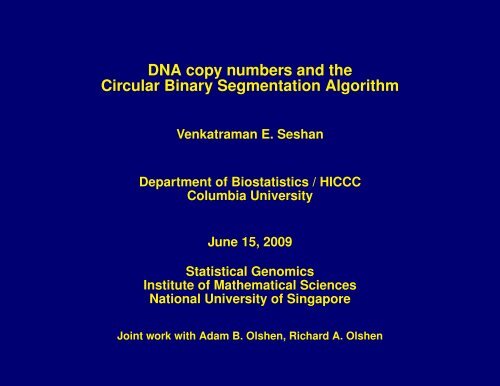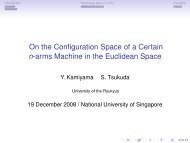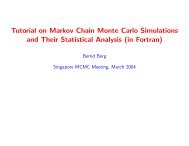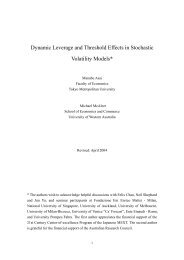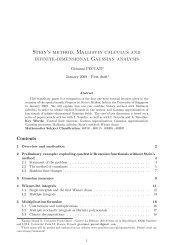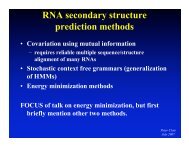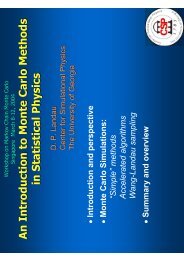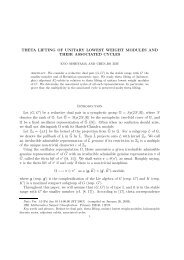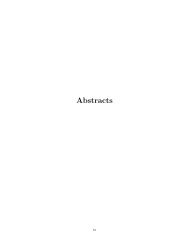DNA copy numbers and the Circular Binary Segmentation Algorithm
DNA copy numbers and the Circular Binary Segmentation Algorithm
DNA copy numbers and the Circular Binary Segmentation Algorithm
Create successful ePaper yourself
Turn your PDF publications into a flip-book with our unique Google optimized e-Paper software.
<strong>DNA</strong> <strong>copy</strong> <strong>numbers</strong> <strong>and</strong> <strong>the</strong><br />
<strong>Circular</strong> <strong>Binary</strong> <strong>Segmentation</strong> <strong>Algorithm</strong><br />
Venkatraman E. Seshan<br />
Department of Biostatistics / HICCC<br />
Columbia University<br />
June 15, 2009<br />
Statistical Genomics<br />
Institute of Ma<strong>the</strong>matical Sciences<br />
National University of Singapore<br />
Joint work with Adam B. Olshen, Richard A. Olshen
CBS<br />
Background<br />
• The <strong>DNA</strong> sequence <strong>copy</strong> number at any locus in a genome<br />
is <strong>the</strong> number of copies of genomic <strong>DNA</strong>.<br />
• The normal <strong>copy</strong> number is two for human autosomes.<br />
• Copy number alterations are gains <strong>and</strong> losses of <strong>DNA</strong><br />
* <strong>the</strong>y modify <strong>the</strong> function <strong>and</strong>/or expression of genes<br />
* <strong>the</strong>y are common in cancer: <strong>copy</strong> number<br />
- Increased at sites of oncogenes;<br />
- Decreased at sites of tumor suppressor genes.<br />
1
CBS<br />
Background<br />
Comparative genomic hybridization<br />
• first to scan entire genome for <strong>copy</strong> number variation<br />
Kallioniemi, et al (1992), du Manoir et al (1993)<br />
• metaphase chromosomes from test <strong>and</strong> reference samples<br />
• imaged separately using fluorescence microscope<br />
• quantified using image analysis software<br />
• smooth signal – “continuous curve”, low resolution<br />
http://amba.charite.de/cgh/cgh01.html<br />
2
CBS<br />
Background<br />
Array based methods<br />
• <strong>DNA</strong> extracted, fragmented, labeled <strong>and</strong> hybridized<br />
• different probes<br />
* Bacterial artificial clones (BACs) (1-3k orig, 31k tiling)<br />
* Long oligo arrays: Agilent (44k, 244k),<br />
Nimblegen (350k), ROMA (85k+)<br />
* Short oligos – Affymetrix SNP arrays (100k, 500k, 1.8m)<br />
• higher resolutions – noisier<br />
• Review: Pinkel & Albertson (2005, Nature Genetics)<br />
3
CBS<br />
Example<br />
Lung cancer BAC array with 3160 clones<br />
log−ratio<br />
−2 −1 0 1 2<br />
0 500 1000 1500 2000 2500 3000<br />
Genomic Position<br />
4
CBS<br />
Example<br />
Breast cancer ROMA array with 9820 probes<br />
log−ratio<br />
−2 −1 0 1 2<br />
0 500 1000 1500 2000 2500 3000<br />
Genomic Position<br />
5
CBS<br />
Analysis<br />
Overall plan<br />
In sample identify regions of abnormal <strong>copy</strong> number<br />
Region(s) repeatedly deleted or amplified across samples<br />
How to identify locations of aberrations?<br />
Thresholds: 3 SDs above 0 is a gain, 3 below is a loss<br />
SDs estimated from probe level data of normal/normal experiments<br />
Alteration calls can oscillate due to data overlap<br />
Smoothing techniques (lowess, quantreg, wavelets etc.)<br />
6
CBS<br />
Analysis<br />
Copy number alterations are discrete events<br />
affecting contiguous regions of <strong>the</strong> genome<br />
• Hodgson et al. (2001) - 3-component Gaussian mixture<br />
• Autio et al. (2003) - CGH-Plotter: 3-means clustering<br />
combined with dynamic programming<br />
• Fridly<strong>and</strong> et al. (2004) - Gaussian hidden Markov model<br />
• Wang et al. (2005) - Clustering along chromosomes<br />
• Tibshirani <strong>and</strong> Wang (2008) - cghFlasso<br />
Our algorithm based on a change-point model<br />
Olshen, Venkatraman, Lucito & Wigler (2004)<br />
7
CBS Change-points Methods<br />
Let Z 1 , Z 2 , . . . , Z n be <strong>the</strong> data ordered by an indexing set<br />
If Z 1 , . . . , Z ν ∼ F 0 <strong>and</strong> Z ν+1 , . . . , Z n ∼ F 1 ,<br />
<strong>the</strong>n ν is a change-point (Page, 1954).<br />
For our problem<br />
• <strong>the</strong> data are <strong>the</strong> log-ratio measurements<br />
• ordered by <strong>the</strong> location of a probe on a chromosome<br />
• a change-point corresponds to where<br />
<strong>the</strong> <strong>copy</strong> number changed on a chromosome<br />
• There may be multiple changes.<br />
8
CBS Change-points Methods<br />
<strong>Binary</strong> segmentation (Sen <strong>and</strong> Srivastava, 1975; Vostrikova, 1981)<br />
1. Partial sums: S i = Z 1 + · · · + Z i , i = 1, . . . , n<br />
2. Test <strong>the</strong> hypo<strong>the</strong>sis H 0 : no change against H 1 : ν = i<br />
Statistic if Zs are normal is S i<br />
i − S n−S i<br />
n−i<br />
3. Unknown ν - maximize <strong>the</strong> t-statistic over all i<br />
It is a recursive procedure - segments <strong>the</strong> data at a<br />
change-point <strong>and</strong> tests for change-points in <strong>the</strong> segments<br />
Tail probability approximation by Siegmund (1986)<br />
9
CBS <strong>Binary</strong> <strong>Segmentation</strong> Fails Methods<br />
Chromosome 12 Max t-statistic: 4.242/3.462, p-value: 0.221/0.254<br />
log−ratio<br />
−2 −1 0 1 2<br />
1940 1960 1980 2000 2020 2040 2060 2080<br />
Genomic Position<br />
10
CBS <strong>Binary</strong> <strong>Segmentation</strong> Fails Methods<br />
11
CBS <strong>Circular</strong> <strong>Binary</strong> <strong>Segmentation</strong> Methods<br />
View <strong>the</strong> data as if on a circle <strong>and</strong> segment into two arcs.<br />
Partial sums: S i = Z 1 + · · · + Z i , i = 1, . . . , n<br />
Test statistic: T =<br />
max<br />
1 ≤ i < j ≤ N<br />
|T ij |, where<br />
⌢<br />
Z ij − ⌣ Z ij<br />
T ij =<br />
s √ (j − i) −1 + (i + n − j) −1,<br />
⌢<br />
Z ij = (S j − S i )/(j − i)<br />
<strong>and</strong><br />
⌣<br />
Z ij = {S i + (S n − S j )}/(i + n − j)<br />
Hence named circular binary segmentation (CBS).<br />
Ei<strong>the</strong>r one change-point (j = n) or two (j < n).<br />
Levin <strong>and</strong> Kline (1985): Similar statistic for epidemic alternative<br />
12
CBS More on CBS Methods<br />
• Recursively split <strong>the</strong> data if p-value below threshold<br />
• Tail probability approximation for Normal data<br />
– Siegmund (1988); Yao (1989)<br />
• Calculate reference distribution by permuting<br />
• If ternary split, <strong>the</strong> first <strong>and</strong> third segment are tested for<br />
a binary split with <strong>the</strong> middle segment (edge effect)<br />
• <strong>Algorithm</strong>ic tweaks:<br />
* Maximize difference in means for fixed segment length<br />
* Stop permutations once p-value exceeds threshold<br />
* Moving windows for large data sets (deprecated)<br />
13
CBS More on CBS Example<br />
−2 −1 0 1 2<br />
xx2$log2R<br />
log−ratio<br />
log−ratio<br />
−2 −1 0 1 2<br />
xx2$genomic.pos<br />
0 500 1000 1500 2000 2500 3000<br />
Genomic Position<br />
14
CBS Faster CBS Example<br />
CBS performed consistently well (Lai et al., 2005) but slow<br />
has superior performance (Willenbrock <strong>and</strong> Fridly<strong>and</strong>, 2005)<br />
Why is CBS slow?<br />
• Test statistic: require n(n − 1)/2 computations<br />
• Reference distribution is based on permutation<br />
• Not a problem for 3k BAC arrays but larger arrays?<br />
Especially 350k, 500k arrays (let alone 1.8m or 4m)<br />
Improvements: hybrid p-value & a stopping rule for change<br />
Venkatraman & Olshen (2007)<br />
15
CBS Hybrid p-value Faster CBS<br />
Test statistic T = max{T 1 , T 2 } where<br />
T 1 = max<br />
A 1<br />
|T ij | <strong>and</strong> T 2 = max<br />
A 2<br />
|T ij |<br />
A 1 = {i, j : j − i ≤ k or > n − k} (small arcs)<br />
A 2 = {i, j : k + 1 ≤ j − i ≤ n − k} (non-small arcs)<br />
Choose k to call an arc small<br />
Split data if P (T > T obs ) < α<br />
Bound P (T > T obs ) ≤ P (T 1 > T obs ) + P (T 2 > T obs )<br />
Use permutation for P (T 1 > T obs ) <strong>and</strong><br />
Approximate P (T 2 > T obs ) (Siegmund (1988), Yao (1993))<br />
16
CBS p-value Approximation Faster CBS<br />
Let ˜T 2 = max<br />
A 2<br />
T ij . If data are normal, <strong>the</strong>n<br />
P ( ˜T 2 > b) = 1 4 b3 φ(b)<br />
∫ 1−δ<br />
1/2<br />
ν 2 (b/[nt(1 − t)] 1/2 )<br />
t 2 (1 − t) 2 dt,<br />
where δ = k/n, φ is <strong>the</strong> normal density <strong>and</strong> ν is<br />
⎧<br />
⎨ ∞<br />
ν(x) = 2x −2 exp<br />
⎩ −2 ∑<br />
r −1 Φ<br />
(− 1 ) ⎫ ⎬<br />
2 xr1/2 ⎭ .<br />
By symmetry P (T 2 > b) ≈ 2P ( ˜T 2 > b).<br />
If data are “regular” <strong>and</strong> k sufficiently large,<br />
r<strong>and</strong>om field approximately Gaussian<br />
1<br />
17
CBS Stopping rule Faster CBS<br />
• data segmented if p-value ≤ α<br />
• p-value computed from P permuted statistics<br />
• all P permutations conducted when change detected<br />
• what if none of <strong>the</strong> first 1000 T perm > T obs<br />
Number T perm > T obs<br />
0 20 40 60 80 100<br />
0 2000 4000 6000 8000 10000<br />
Number of permutations<br />
18
CBS Stopping rule Faster CBS<br />
Let e 1 , . . . , e P be <strong>the</strong> indicators of T perm > T obs<br />
i∑<br />
Let r(i) = e j . Declare no change if r(i) = αP = m<br />
1<br />
• Stopping rule to declare change is a boundary b 1 , . . . , b m<br />
• Stop <strong>and</strong> declare change detected if r(b i ) < i<br />
• Choosing <strong>the</strong> boundary? – Repeated significance test<br />
• Control Prob{r(b i ) < i for some i|r(P) = m} at η<br />
• b i is <strong>the</strong> smallest j such that Prob{r(j) < i} = η ⋆<br />
• obtained using <strong>the</strong> hypergeometric distribution<br />
19
CBS Performance gain Faster CBS<br />
100k SNP array data for 3 breast cancer cell lines<br />
data from http://pevsnerlab.kennedykrieger.org/snpscan.htm<br />
Cell line Time in<br />
MCF7 SKBR3 ZR75 minutes<br />
P 220 242 270 7085.8<br />
H 217 242 271 100.2<br />
H+ES 216 243 269 25.0<br />
Identical 213 242 263<br />
20
CBS Lung project Example<br />
• Two broad categories of lung cancer: small cell (SCLC)<br />
<strong>and</strong> non-small cell (NSCLC)<br />
• Adenocarcinoma is a histological subtype of NSCLC<br />
• Recent advance: EGFR mutation <strong>and</strong> effective TKI drugs<br />
• Prognosis is in general poor especially KRAS mutation<br />
Can we learn more by profiling <strong>DNA</strong> <strong>copy</strong> number?<br />
≈ 250 samples using Agilent 44k arrays.<br />
Also gene expressions using Affy U133 arrays<br />
21
CBS Lung Project Example<br />
22
CBS Lung Project Example<br />
23
CBS Lung Project Example<br />
24
CBS Lung Project Example<br />
!"##$%&%'()*+,-./"*%,0<br />
25
CBS Lung Project Example<br />
-./0123"<br />
&'( *'#<br />
$")(<br />
!"#"<br />
!"#$<br />
$)( *)(<br />
+'( $,)(<br />
!%#%<br />
!%#"<br />
!%#$<br />
26
CBS Lung Project Example<br />
• No obvious focal gain or loss stood out<br />
• Clusters had weak association with EGFR but not KRAS<br />
• Incorporated information from U133 expression arrays<br />
• Potentially interesting gene DUSP4<br />
Acknowledgements<br />
Marc Ladanyi, William Gerald, Valerie Rusch, Stephen Broderick,<br />
Cameron Brennan, Dhananjay Chitale, Bhuvanesh Singh <strong>and</strong> o<strong>the</strong>rs.<br />
27
CBS Copy Number Variation TCGA<br />
28
CBS Multi platform data wCBS<br />
• Method to merge data from multiple platforms<br />
• Platform specific probe noise - weights w i<br />
• Partial sums: S i = w 1 Z 1 + · · · + w i Z i ,<br />
W i = w 1 + · · · + w i<br />
i = 1, . . . , n<br />
• Test statistic: T =<br />
max<br />
1 ≤ i < j ≤ N<br />
|T ij |, where<br />
T ij =<br />
⌢<br />
Z ij − ⌣ Z ij<br />
s<br />
√(W j − W i ) −1 + (W i + W n − W j ) −1,<br />
⌢<br />
Z ij = (S j − S i )/(W j − W i )<br />
<strong>and</strong><br />
⌣<br />
Z ij = {S i + (S n − S j )}/(W i + W n − W j )<br />
29
CBS Multi platform data wCBS<br />
Weighted CBS uses <strong>the</strong> same hybrid approach.<br />
Bengtsson, et al (2009)<br />
HaasSeg is a Haar wavelt based segmentation algorithm<br />
30
CBS<br />
ASCN<br />
Allele Specific Copy Number<br />
• Traditional methods measure <strong>the</strong> sum of <strong>copy</strong> <strong>numbers</strong> of<br />
<strong>the</strong> parental chromosomes.<br />
• SNP arrays can be used for allele specific <strong>copy</strong> <strong>numbers</strong>.<br />
• Total <strong>copy</strong> number of 2 can be from AA, AB or BB.<br />
• Data from Molecular Inversion Probes (MIPs) SNP genotyping/<strong>copy</strong><br />
number technology from Affymetrix.<br />
• Intensities for <strong>the</strong> two alleles converted to <strong>copy</strong> <strong>numbers</strong>.<br />
31
CBS MIPs Example ASCN<br />
Allele A <strong>copy</strong> number<br />
0 1 2 3 4 5 6<br />
Allele B <strong>copy</strong> number<br />
0 1 2 3 4 5 6<br />
0 500 1000 1500 2000 2500 3000<br />
Genomic Position (Mb)<br />
0 500 1000 1500 2000 2500 3000<br />
Genomic Position (Mb)<br />
Sum of <strong>copy</strong> <strong>numbers</strong><br />
0 1 2 3 4 5 6<br />
0 500 1000 1500 2000 2500 3000<br />
Genomic Position (Mb)<br />
32
CBS Analysis plan ASCN<br />
• How to estimate parental chromosome <strong>copy</strong> <strong>numbers</strong>?<br />
• Phase ambiguity causes problem.<br />
parental origin of heterozygous SNPs unknown.<br />
Proposed plan:<br />
Begin by segmenting total <strong>copy</strong> number using CBS.<br />
change-points in total present in one of <strong>the</strong> parent<br />
analyze allele specific CN within each segment<br />
33
CBS Allele A vs B ASCN<br />
Homozygotes are non informative for parental CN<br />
Phase ambiguity can lead to 2 heterozygous blobs<br />
Chromosome 1p<br />
Chromosome 1q<br />
Allee B <strong>copy</strong> number<br />
0 1 2 3 4 5<br />
Allee B <strong>copy</strong> number<br />
0 1 2 3 4 5<br />
0 1 2 3 4 5<br />
Allee A <strong>copy</strong> number<br />
0 1 2 3 4 5<br />
Allee A <strong>copy</strong> number<br />
34
CBS Allele A vs B ASCN<br />
Step 2: Determine <strong>the</strong> homozygous locations.<br />
Minimum of A & B<br />
−0.5 0.0 0.5 1.0 1.5 2.0 2.5 3.0<br />
0 500 1000 1500 2000 2500 3000<br />
Genomic Position (Mb)<br />
35
CBS Allele A vs B ASCN<br />
Step 3: Test for additional change-points<br />
Why? TCN = 4 = 3 + 1 = 2 + 2 ASCN<br />
Step 4: Estimate difference in parental <strong>copy</strong> <strong>numbers</strong><br />
mean absolute difference of heterozygous ASCNs<br />
Step 5: Combine parental <strong>copy</strong> <strong>numbers</strong><br />
adjacent segment <strong>copy</strong> number transitions<br />
<strong>copy</strong> <strong>numbers</strong> 1 + 2 → 2 + 3<br />
36
CBS Reconstruction ASCN<br />
Copy <strong>numbers</strong><br />
0 1 2 3 4 5 6<br />
0 500 1000 1500 2000 2500 3000<br />
Genomic Position (Mb)<br />
Total High <strong>copy</strong> Low <strong>copy</strong><br />
37
CBS Reconstruction ASCN<br />
Allele A <strong>copy</strong> number<br />
0 1 2 3 4 5 6<br />
Allele B <strong>copy</strong> number<br />
0 1 2 3 4 5 6<br />
0 500 1000 1500 2000 2500 3000<br />
Genomic Position (Mb)<br />
0 500 1000 1500 2000 2500 3000<br />
Genomic Position (Mb)<br />
Sum of <strong>copy</strong> <strong>numbers</strong><br />
0 1 2 3 4 5 6<br />
0 500 1000 1500 2000 2500 3000<br />
Genomic Position (Mb)<br />
38
CBS Equality of parental CN ASCN<br />
Chromosome 1p<br />
Chromosome 1q<br />
Chromosome 6p<br />
Allee B <strong>copy</strong> number<br />
0 1 2 3 4 5<br />
0 1 2 3 4 5<br />
Allee A <strong>copy</strong> number<br />
Chromosome 1p<br />
0 1 2 3 4 5<br />
Allee A <strong>copy</strong> number<br />
Density<br />
0.0 0.2 0.4 0.6 0.8 1.0 1.2<br />
Density<br />
0.0 0.1 0.2 0.3 0.4 0.5<br />
Allee B <strong>copy</strong> number<br />
0 1 2 3 4 5<br />
Allee B <strong>copy</strong> number<br />
0 1 2 3 4 5<br />
Chromosome 1q<br />
0 1 2 3 4 5<br />
Allee A <strong>copy</strong> number<br />
Chromosome 6p<br />
Density<br />
0.0 0.5 1.0 1.5 2.0<br />
−2 −1 0 1 2<br />
N = 678 B<strong>and</strong>width = 0.09884<br />
−3 −2 −1 0 1 2 3<br />
N = 604 B<strong>and</strong>width = 0.2596<br />
−2 −1 0 1 2<br />
N = 290 B<strong>and</strong>width = 0.05112<br />
39
CBS Equality of parental CN ASCN<br />
Chromosome 6q<br />
Chromosome 14<br />
Chromosome 15<br />
Allee B <strong>copy</strong> number<br />
0 1 2 3 4 5<br />
0 1 2 3 4 5<br />
Allee A <strong>copy</strong> number<br />
Chromosome 6q<br />
0 1 2 3 4 5<br />
Allee A <strong>copy</strong> number<br />
Density<br />
0.0 0.2 0.4 0.6<br />
Density<br />
0.0 0.2 0.4 0.6 0.8 1.0 1.2<br />
Allee B <strong>copy</strong> number<br />
0 1 2 3 4 5<br />
Allee B <strong>copy</strong> number<br />
0 1 2 3 4 5<br />
Chromosome 14<br />
0 1 2 3 4 5<br />
Allee A <strong>copy</strong> number<br />
Chromosome 15<br />
Density<br />
0.0 0.5 1.0 1.5 2.0<br />
−2 −1 0 1 2<br />
N = 468 B<strong>and</strong>width = 0.2054<br />
−1.0 −0.5 0.0 0.5 1.0<br />
N = 414 B<strong>and</strong>width = 0.09307<br />
−1.0 −0.5 0.0 0.5 1.0<br />
N = 408 B<strong>and</strong>width = 0.04398<br />
40
CBS<br />
Summary<br />
• New technologies for studying biological process present<br />
interesting applications of statistical techniques<br />
• The CBS algorithm is a practical solution which is widely<br />
used to study <strong>DNA</strong> <strong>copy</strong> number data<br />
• Improvements make it highly attractive for larger arrays<br />
• Software is available as an open source R (www.r-project.<br />
org) library called <strong>DNA</strong><strong>copy</strong> that is part of Bioconductor<br />
(www.bioconductor.org).<br />
41
CBS<br />
References<br />
1. Autio, R. et al. (2003). CGH-Plotter: MATLAB toolbox for CGH-data analysis. Bioinformatics 19 1714-1715.<br />
2. du Manoir, S. et al. (1993). Detection of complete <strong>and</strong> partial chromosome gains <strong>and</strong> losses by comparative genomic in situ<br />
hybridization. Hum. Genet. 90, 590610.<br />
3. Fridly<strong>and</strong>, J. et al. (2004). Underst<strong>and</strong>ing Array CGH Data. JMVA 90 132-153.<br />
4. Hodgson, G. et al. (2001). Genome scanning with array CGH delineates regional alterations in mouse islet carcinomas. Nature<br />
Genet. 29 459-464.<br />
5. Kallioniemi, A. et al. (1992). Comparative genomic hybridization for molecular cytogenetic analysis of solid tumors. Science<br />
258, 818821.<br />
6. Lai et al. (2005) Comparative analysis of algorithms for identifying amplifications <strong>and</strong> deletions in array CGH data. Bioinformatics<br />
21, 3763-3770.<br />
7. Levin, B. <strong>and</strong> Kline, J. (1985). The CUSUM test of homogeneity with an application in spontaneous abortion epidemiology.<br />
Statistics in Medicine 4 469-488.<br />
8. Linn, S. et al. (2003). Gene expression patterns <strong>and</strong> <strong>copy</strong> number changes in dermafibrosarcoma Am J Pathol 163 2383-2395.<br />
9. Menard, S. et al. (2002). Role of HER2 gene overexpression in breast carcinoma. J Cell Physiol 182 150-162.<br />
10. Olshen, A., Venkatraman, E., Lucito, R. <strong>and</strong> Wigler, M. (2004). <strong>Circular</strong> <strong>Binary</strong> <strong>Segmentation</strong> for <strong>the</strong> analysis of<br />
array-based <strong>DNA</strong> <strong>copy</strong> number data. Biostatistics 5 557-572.<br />
11. Page, E. S. (1954). Continuous inspection schemes. Biometrika. 41 100-115.<br />
12. Picard, F. et al. (2005) A statistical approach for array CGH data analysis. BMC Bioinformatics 6, 27.<br />
13. Pinkel, D. <strong>and</strong> Albertson, D. (2005) Array comparative genomic hybridization <strong>and</strong> its application in cancer, Nature Genetics,<br />
37, S11-S17, Suppl. S.<br />
14. Pollack, J. R. et al. (2002). Microarray analysis reveals a major direct role of <strong>DNA</strong> <strong>copy</strong> number alteration in <strong>the</strong> transcriptional<br />
program of human breast tumors Proc. Natl. Acad. Sci. 99 12963-12968.<br />
15. Sen, A. <strong>and</strong> Srivastava, M. S. (1975). On tests for detecting a change in mean. Ann Statist. 3 98-108.<br />
16. Siegmund, D. (1986). Boundary crossing probabilities <strong>and</strong> statistical applications. Ann Statist. 14 361-404.<br />
17. Siegmund, D.O. (1988) Approximate tail probabilities for <strong>the</strong> maxima of some r<strong>and</strong>om fields, Annals of Probability, 16, 487-501.<br />
18. Snijders, A. M. et al. (2001). Assembly of microarrays for genome-wide measurement of <strong>DNA</strong> <strong>copy</strong> number. Nature Genet. 29<br />
263-264.<br />
19. Tibshirani, R. <strong>and</strong> Wang, P. (2007) Spatial smoothing <strong>and</strong> hot spot detection for CGH data using <strong>the</strong> Fused Lasso. Biostatistics<br />
20. Venkatraman, E. S. <strong>and</strong> Olshen, A. B. (2007) A faster circular binary segmentation algorithm for <strong>the</strong> analysis of array CGH<br />
data. Bioinformatics.<br />
42
CBS<br />
References<br />
21. Vostrikova, L. J. (1981) Detecting “disorder” in multidimensional r<strong>and</strong>om processes. Soviet Ma<strong>the</strong>matics Doklady 24 55-59.<br />
22. Wang, P. et al. (2005). A method for calling gains <strong>and</strong> losses in array CGH data. Biostatistics 6 45-58.<br />
23. Willenbrock, H. <strong>and</strong> Fridly<strong>and</strong>, J. (2005) A comparison study: applying segmentation to array CGH data for downstream<br />
analyses. Bioinformatics, 21, 4084-4091.<br />
24. Yao, Q. (1989) Large deviations for bounary crossing probabilities of some r<strong>and</strong>om fields. J. Math, Res. Exposition, 9, 181-192.<br />
25. Yao, Q. (1993) Tests for change-points with epidemic alternatives, Biometrika, 80, 179-191.<br />
43


